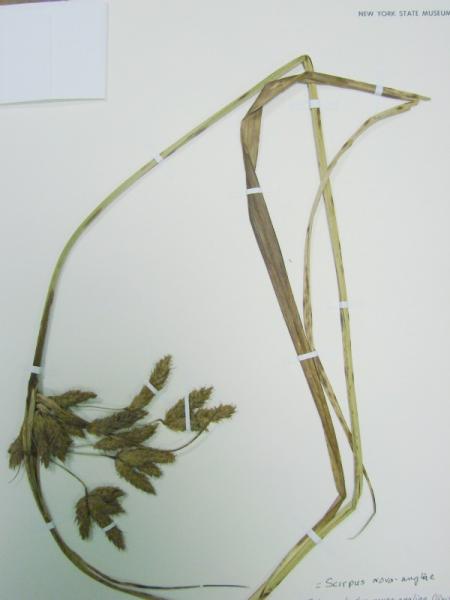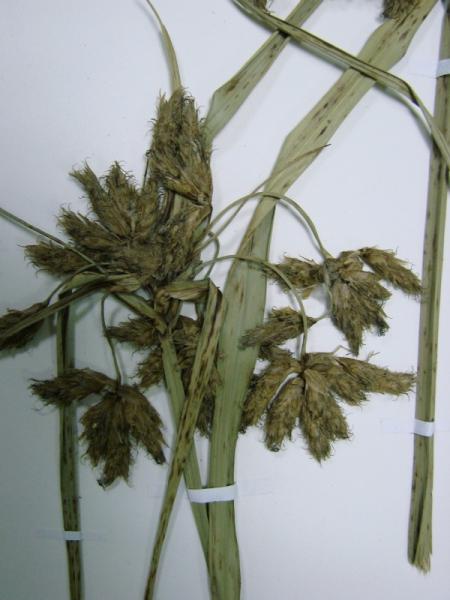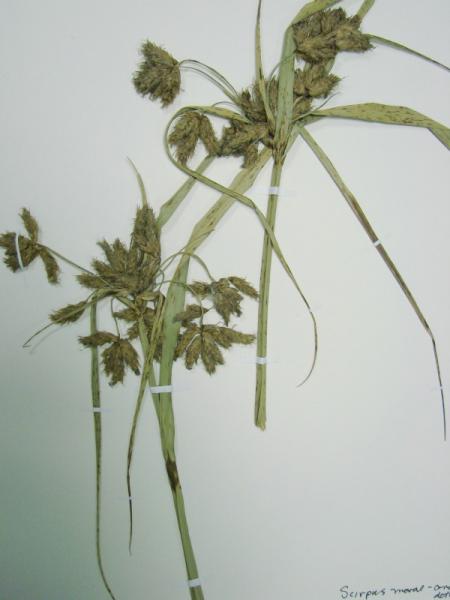New England Bulrush
Bolboschoenus novae-angliae (Britt.) S.G. Sm.
- Class
- Monocotyledoneae (Monocots)
- Family
- Cyperaceae (Sedge Family)
- State Protection
- Endangered
Listed as Endangered by New York State: in imminent danger of extirpation in New York. For animals, taking, importation, transportation, or possession is prohibited, except under license or permit. For plants, removal or damage without the consent of the landowner is prohibited.
- Federal Protection
- Not Listed
- State Conservation Status Rank
- S1
Critically Imperiled in New York - Especially vulnerable to disappearing from New York due to extreme rarity or other factors; typically 5 or fewer populations or locations in New York, very few individuals, very restricted range, very few remaining acres (or miles of stream), and/or very steep declines.
- Global Conservation Status Rank
- G3
Vulnerable globally - At moderate risk of extinction due to rarity or other factors; typically 80 or fewer populations or locations in the world, few individuals, restricted range, few remaining acres (or miles of stream), and/or recent and widespread declines.
Summary
Did you know?
The genus name is derived from the Greek words meaning bulb and rush, and refers to the underground corms that characterize this genus. This species is probably of hybrid origin because its characters and habitat preference is intermediate between the freshwater species Bolboschoenus fluviatilis and the salt water species Bolboschoenus robustus (Flora of North America 2002).
State Ranking Justification
There are four existing populations and three of them are of good size. There are three additional historical locations which are probably extirpated.
Short-term Trends
At two sites the short-term trend seems stable after multiple visits. At two other sites there has only been one visit each.
Long-term Trends
This species was never common in New York with only six historical records. Four of those records were rediscovered and two are probably extirpated. One new site has been discovered so the long-term trend of the species has not changed significantly over the last 100 years.
Conservation and Management
Threats
Water chemistry changes from disturbance leads to phragmites invasion and all of the occurrences could be affected by phragmites in the future. One historical location was eliminated by phragmites.
Conservation Strategies and Management Practices
The sites where this plant occurs may be hard to protect from water chemistry changes and Phragmites invasion.
Habitat
Habitat
Saltmarsh Bulrush is found in brackish marshes along tidal creeks and rivers. A hybrid, it apparently has a habitat niche intermediate between those of its parents -- occupying sites saltier than those of B. fluviatilis, but fresher than those of B. robustus (FNA 2002, New York Natural Heritage Program 2007). Saline to brackish marshes and brackish to fresh tidal shores (Fernald 1970). Brackish transitional zones of tidal river systems (Gleason and Cronquist 1991).
Associated Ecological Communities
- Brackish tidal marsh
(guide)
A marsh community that occurs where water salinity ranges from 0.5 to 18.0 ppt, and water is less than 2 m (6 ft) deep at high tide. The vegetation in a brackish tidal marsh is dense and dominated by tall grass-like plants.
- Tidal river
(guide)
The aquatic community of a river under the influence of daily lunar tides. We restrict this community to the continuously flooded portions of the river where plants do not grow out of the water. A deepwater zone has depths averaging more than 2 m (6 ft) at low tide. Salinities at any one place in the river may fluctuate as the tides flow in and out.
Associated Species
- Bolboschoenus robustus (sea-coast bulrush)
- Lythrum salicaria (purple loosestrife)
- Phragmites australis (old world reed grass, old world phragmites)
- Spartina alterniflora (smooth cord grass)
- Spartina cynosuroides (big cord grass)
- Typha angustifolia (narrow-leaved cat-tail)
Range
New York State Distribution
Salt-marsh Bulrush occurs in New York from Western Long Island and New York City to the Lower Hudson River Valley, as far upstream as Orange County.
Global Distribution
This species occurs on coasts and in estuaries from Maine in the north through the mid-Atlantic states to Virginia. There is also a single record from Georgia.
Identification Comments
General Description
Saltmarsh Bulrush is a stout perennial plant, arising from tuberous rhizomes, with a stout, triangular stem up to 1.5 m tall. The leaves sheath the stem for at least half its length, and the leaf blades are 6 to 13 mm wide. The fruit are achenes, tightly packed into solitary or clustered spikelets, these in turn organized into subumbellate infloresences, the clusters of spikelets separated on rays (branches) not more than 8 cm long.
Best Life Stage for Proper Identification
Mature fruit are needed to identify this species.
Similar Species
Saltmarsh bulrush is believed to have originated as a hybrid between Bolboschoenus fluviatilis and B. robustus. It is intermediate in both habitat and certain anatomical characteristics. In addition to habitat characteristics, it can be distinguished from B. fluviatilis by having lenticular to trigonous achenes with the perianth bristles weakly attached or soon falling away , whereas B. fluviatilis has markedly trigonous achenes, with the perianth bristles firmly attached. B. novae-angliae differs from B. robustus, as well as from B. maritimus, another species of concern in New York, in having most or all of the infloresences on elongate branches, whereas at least half of the infloresences of B. robustus and B. maritimus are sessile.
Best Time to See
Bulboschoenus novae-angliae flowers in June and July, and the fruits persist through September.
- Flowering
- Fruiting
The time of year you would expect to find New England Bulrush flowering and fruiting in New York.
New England Bulrush Images
Taxonomy
New England Bulrush
Bolboschoenus novae-angliae (Britt.) S.G. Sm.
- Kingdom Plantae
- Phylum Anthophyta
- Class Monocotyledoneae
(Monocots)
- Order Cyperales
- Family Cyperaceae (Sedge Family)
- Order Cyperales
- Class Monocotyledoneae
(Monocots)
- Phylum Anthophyta
Additional Common Names
- Saltmarsh Bulrush
Synonyms
- Schoenoplectus novae-angliae (Britt.) M. T. Strong
- Scirpus cylindricus (Torr.) Britt. [a nomen illeg.]
- Scirpus novae-angliae Britt.
- Scirpus robustus Pursh [in part.]
Additional Resources
Best Identification Reference
Flora of North America Editorial Committee. 2002b. Flora of North America north of Mexico. Vol. 23. Magnoliophyta: Commelinidae (in part): Cyperaceae. Oxford Univ. Press, New York. xxiv + 608 pp.
Other References
Crow, Garrett E. and C. Barre Hellquist. 2000. Aquatic and wetland plants of northeastern North America: A revised and enlarged edition or Norman C. Fassett's a manual of aquatic plants. Volume two angiosperms: Monocotyledons. The University of Wisconsin Press. Madison, Wisconsin. 456 pp.
Fernald, M.L. 1950. Gray's manual of botany. 8th edition. D. Van Nostrand, New York. 1632 pp.
Gleason, Henry A. and A. Cronquist. 1991. Manual of Vascular Plants of Northeastern United States and Adjacent Canada. The New York Botanical Garden, Bronx, New York. 910 pp.
Haines, Arthur and Thomas F. Vining. 1998. Flora of Maine. A Manual for Identification of Native and Naturalized Vascular Plants of Maine.
Holmgren, Noel. 1998. The Illustrated Companion to Gleason and Cronquist's Manual. Illustrations of the Vascular Plants of Northeastern United States and Adjacent Canada. The New York Botanical Garden, Bronx, New York.
New York Natural Heritage Program. 2010. Biotics database. New York Natural Heritage Program. New York State Department of Environmental Conservation. Albany, NY.
New York Natural Heritage Program. 2024. New York Natural Heritage Program Databases. Albany, NY.
Schuyler, Alfred E. 1974. Scirpus cylindricus: An ecologically restricted eastern North American tuberous bulrush. Bartonia 43: 29-37.
Weldy, T. and D. Werier. 2010. New York flora atlas. [S.M. Landry, K.N. Campbell, and L.D. Mabe (original application development), Florida Center for Community Design and Research http://www.fccdr.usf.edu/. University of South Florida http://www.usf.edu/]. New York Flora Association http://newyork.plantatlas.usf.edu/, Albany, New York
Weldy, Troy W. and David Werier. 2005. New York Flora Atlas. [S.M. Landry, K.N. Campbell, and L.D. Mabe (original application development), Florida Center for Community Design and Research. University of South Florida]. New York Flora Association, Albany, NY. Available on the web at (http://newyork.plantatlas.usf.edu/).
Links
About This Guide
Information for this guide was last updated on: January 18, 2008
Please cite this page as:
New York Natural Heritage Program. 2024.
Online Conservation Guide for
Bolboschoenus novae-angliae.
Available from: https://guides.nynhp.org/saltmarsh-bulrush/.
Accessed July 27, 2024.




